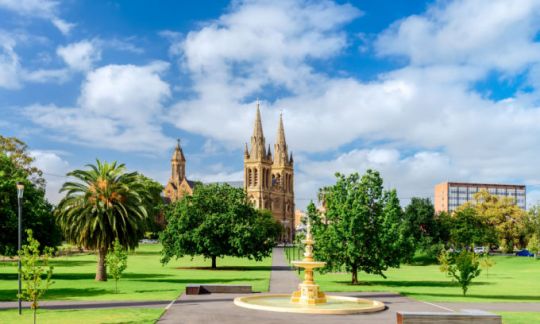How much stamp duty do you pay on property in South Australia?
Stamp duty can be a considerable upfront cost when you buy a home in South Australia. We explore how it works, as well as the other government charges worth planning ahead for.

Stamp duty can be a considerable upfront cost when you buy a home in South Australia. We explore how it works, as well as the other government charges worth planning ahead for.
Thinking about buying a property in South Australia? Don’t forget to factor in the cost of stamp duty. We’ve broken down how stamp duty is calculated for South Australian property buyers and how to avoid stamp duty through exemptions and potentially save through concessions that may apply.
What is stamp duty?
Stamp duty is a one-off government tax that’s commonly imposed when you buy or acquire property. As stamp duty is charged by state and territory governments, the rules on how it’s calculated can vary from place to place. However, a general rule is: the more expensive your property is, the more stamp duty you’ll need to pay.
Stamp duty is primarily determined by three major factors:
- The state or territory you’re buying the property in,
- the value of the property, and
- whether you’re eligible for any concessions or exemptions.
Let’s take a look at how stamp duty is calculated in South Australia.
How is stamp duty calculated in South Australia?
In South Australia, stamp duty is calculated by applying the stamp duty rate, as set by RevenueSA, to your property’s market value or purchase price, whichever of the two is higher. This means that even if you didn’t purchase the property – for example if it was given to you as a gift – you may still need to pay stamp duty based on the property’s market value.
If you’re a foreign purchaser acquiring an interest in residential land in South Australia, RevenueSA says it imposes an additional foreign ownership surcharge. At the time of writing, this is 7% of the value of the interest in the land.
Stamp duty calculator SA (South Australia)
You can get an idea for the stamp duty cost in South Australia that you’re likely to pay with our Stamp Duty Calculator. Select SA from the dropdown menu to get started.
Who has to pay stamp duty in South Australia?
Stamp duty is payable on all residential or primary production (farming) land purchased in South Australia. It is generally the responsibility of the property buyer to pay stamp duty.
RevenueSA says that land is considered to be for ‘residential purposes’ even if it isn’t occupied but has undergone improvements that are “residential in character”, or if the land is vacant but is within a development zone where the purpose of the land would be envisaged as residential. Be sure to check with RevenueSA about how land you’re considering might be classified.
RevenueSA says stamp duty also applies to the transfer of property by investors as well as those intending to live in the property.
Do you pay stamp duty on land in South Australia?
You may well be wondering, if you purchase land without a house on it in South Australia, do you pay stamp duty on the land itself? According to Revenue SA, stamp duty is payable when you buy or acquire residential or primary production land in South Australia. This means that, if you buy an empty block of land, you would need to pay stamp duty on it, as you would if it came with a pre-existing house.
Do you pay stamp duty on a new build?
In South Australia, stamp duty is only paid when purchasing the land, not when a house is being built on said land. However, if you’re buying a house and land package from a developer, where the land and house are purchased together, you’ll typically have to pay stamp duty on the combined value. It’s important to check with a conveyancing expert or RevenueSA to see if this is the case for your package.
When is stamp duty paid in South Australia?
The South Australian Government advises that stamp duty is usually payable at or before settlement. Stamp duty must be paid in order for you to be registered as the owner of the property. If you fail to pay on time, RevenueSA says you may be charged penalty tax and interest. This can be a significant amount – interest is charged at the market rate plus an additional 8% per annum. Meanwhile, penalty tax can climb up to 75% of the amount owing if you deliberately didn’t pay your tax or can be 25% in other cases. You may also be able to negotiate with your lender to add your stamp duty to your mortgage.
Your solicitor or conveyancer may be able to assist you with completing and lodging stamp duty documents and advising you on key deadlines specific to your transaction.
The comparison rate for all home loans and loans secured against real property are based on secured credit of $150,000 and a term of 25 years.
^WARNING: This comparison rate is true only for the examples given and may not include all fees and charges. Different terms, fees or other loan amounts might result in a different comparison rate.

Up to $4,000 when you take out a IMB home loan. Minimum loan amounts and LVR restrictions apply. Offer available until further notice. See provider website for full details. Exclusions, terms and conditions apply.
 Owner occupied
Owner occupied
 20% min deposit
20% min deposit
 Redraw facility
Redraw facility
 Owner occupied
Owner occupied
 10% min deposit
10% min deposit
 Redraw facility
Redraw facility
 Owner occupied
Owner occupied
 20% min deposit
20% min deposit
 Redraw facility
Redraw facility
 Owner occupied
Owner occupied
 20% min deposit
20% min deposit
 Redraw facility
Redraw facility
 Owner occupied
Owner occupied
 40% min deposit
40% min deposit
 Redraw facility
Redraw facility
Canstar may earn a fee for referrals from its website tables, and from Sponsorship or Promotion of certain products. Fees payable by product providers for referrals and Sponsorship or Promotion may vary between providers, website position, and revenue model. Sponsorship or Promotion fees may be higher than referral fees. Sponsored or Promoted products are clearly disclosed as such on website pages. They may appear in a number of areas of the website such as in comparison tables, on hub pages and in articles. Sponsored or Promoted products may be displayed in a fixed position in a table, regardless of the product’s rating, price or other attributes. The table position of a Sponsored or Promoted product does not indicate any ranking or rating by Canstar. For more information please see How We Get Paid.
Are there any stamp duty concessions in South Australia?
South Australia has introduced a stamp duty relief for first home buyers starting June 6, 2024. Eligible buyers of a new home, off-the-plan apartment, or vacant land to build a home can receive full relief, provided the property will be used as their primary residence. There are currently no property value caps for eligible applicants, but this could change over time. It’s important to check the RevenueSA website for details on conditions and eligibility.
There is also a First Home Owner Grant in SA, which has similar eligibility requirements as the above stamp duty relief. You may be eligible for both government initiatives, but you must apply for each separately.
What are the exemptions to paying stamp duty in South Australia?
In some circumstances, you may get a stamp duty exemption in South Australia. According to RevenueSA, some of the instances where you’ll be exempt from paying stamp duty could include:
- Transfers from an estate of a deceased person to a beneficiary under a will.
- Domestic partnership transfers.
- Transfer of farming property between family members.
Other fees and finance considerations when buying property in South Australia
On top of stamp duty, you’ll also generally need to pay a mortgage registration fee (if you’re buying with a home loan) and a transfer registration fee. The mortgage registration fee is a charge for registering a home loan and the property as security on that loan. The transfer registration fee covers the cost of transferring the title of the property. The South Australian Government sets the fees each financial year. The mortgage registration fee is charged as a flat fee of $192 in 2024/25, while the transfer registration fee is calculated based on the value of your property. The RevenueSA and Land Services SA websites provide details on fee updates.
An ongoing land tax may also apply to some property owners in South Australia, which is based on the value of the land excluding buildings or other improvements. If you’re purchasing a home in South Australia, don’t forget about solicitor/conveyancing fees, building and pest inspection fees, plus other upfront costs you might incur.
Related: Home Loan Fees and Extra Costs You Should Know About
First Home Owner Grant South Australia
If you’re buying or building a brand new home to live in, you might be eligible to receive a $15,000 grant under the SA First Home Owner Grant. There are a number of eligibility criteria you must satisfy. Namely, you must be an Australian citizen or permanent resident, you or your partner cannot have held a relevant interest in an Australian residential property prior to 2000, and the market value of your property cannot exceed $650,000. Check with RevenueSA for more information.
Explore further: First Home Owners Grants & Concessions by State
Cover image source: myphotobank.com.au/Shutterstock.com
This article was reviewed by our Senior Finance Journalist Alasdair Duncan before it was updated, as part of our fact-checking process.

- What is stamp duty?
- How is stamp duty calculated in South Australia?
- Who has to pay stamp duty in South Australia?
- Do you pay stamp duty on land in South Australia?
- Do you pay stamp duty on a new build?
- When is stamp duty paid in South Australia?
- Are there any stamp duty concessions in South Australia?
- What are the exemptions to paying stamp duty in South Australia?
- Other fees and finance considerations when buying property in South Australia
- First Home Owner Grant South Australia
The comparison rate for all home loans and loans secured against real property are based on secured credit of $150,000 and a term of 25 years.
^WARNING: This comparison rate is true only for the examples given and may not include all fees and charges. Different terms, fees or other loan amounts might result in a different comparison rate.

Up to $4,000 when you take out a IMB home loan. Minimum loan amounts and LVR restrictions apply. Offer available until further notice. See provider website for full details. Exclusions, terms and conditions apply.
 Owner occupied
Owner occupied
 20% min deposit
20% min deposit
 Redraw facility
Redraw facility
Try our Home Loans comparison tool to instantly compare Canstar expert rated options.
The comparison rate for all home loans and loans secured against real property are based on secured credit of $150,000 and a term of 25 years.
^WARNING: This comparison rate is true only for the examples given and may not include all fees and charges. Different terms, fees or other loan amounts might result in a different comparison rate.






